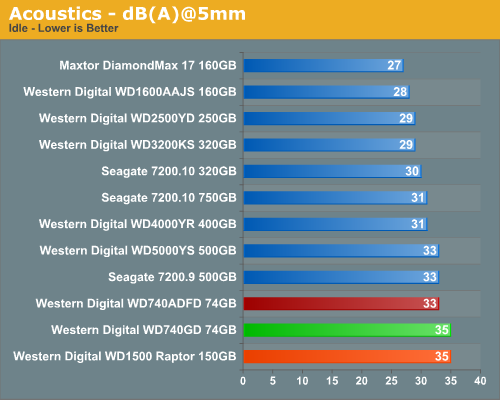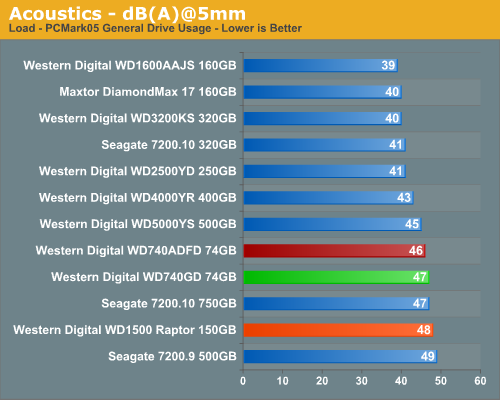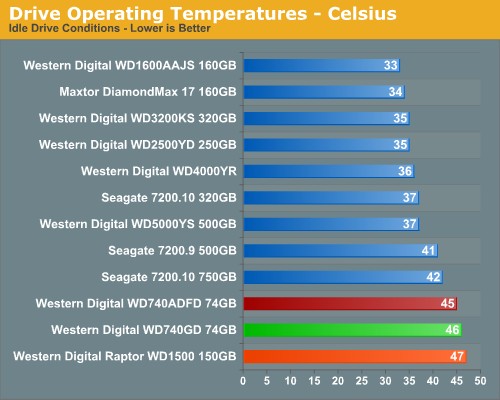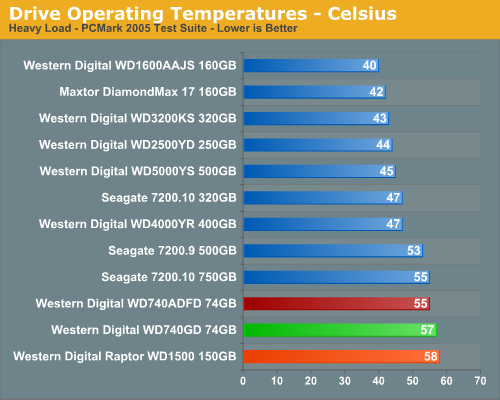Western Digital WD740ADFD: Bottled Lightning
by Gary Key on February 7, 2007 3:30 AM EST- Posted in
- Storage
Hard Drive Acoustics
Our acoustic test utilizes our standard test bed components but we implement AMD's Cool'n'Quiet technology and turn off the case fans to isolate as much case noise as possible during testing. Our OCZ power supply is nearly silent in these tests and our fanless ASUS 7600GS video card provides a further decrease in our case's ambient noise levels. Our drives are attached to the drive cage with rubber bushings to assist in isolating the noise of the drive without resulting harmonic changes due to the case design
Our acoustic tests are designed to measure the decibel levels while the system is at idle and also under load while running the General Hard Disk Drive Usage benchmark within PCMark 2005. We found through trail and error that this particular benchmark produces controlled readings across a wide range of applications within the benchmark. This particular benchmark utilizes 60% reads and 40% writes within the trace playback file.
The measurements are taken at a distance of 5 millimeters from the rear and front of the drive being tested in order to minimize surrounding environmental noise. We have noticed that unless we run a completely silent system in a silent room that measurements taken from 1 meter are generally not meaningful due to ambient noise levels. There are exceptions like the Raptor series of drives but overall most modern desktop drives are quieter now than the other components in the system.
The reported measurements are based on an A-weighted decibel score that measures frequencies similar to the way the human ear responds to sound. We take a total of three measurements for each test. We then subtract the high and low scores and arrive at our findings by reporting the remaining score.


Our Western Digital WD740ADFD is quieter than the other Raptors in our objective testing, but we thought the results would be even better after listening to the drive during testing. Our subjective opinion is that the seek requests on the WD740ADFD are muted a great deal when compared to the other two Raptors. In fact the difference was notable to us although it did not show up completely in our objective tests. Our base dB(A) level in the room at time of testing was 24 dB(A).
Hard Drive Thermals
Our thermal tests utilize sensor readings via the S.M.A.R.T. (Self-Monitoring, Analysis and Reporting Technology) capability of the drives and are reported by utilizing the Active SMART 2.42 utility. We test our drives in an enclosed case environment without the front fan operational to simulate temperatures that could conceivably be reached in a SFF or HTPC case design. We typically find the reported numbers drop anywhere from 18% to 25% on average when the front fan is operational.


We expected the WD740ADFD to run slightly cooler than either the WD1500ADFD or WD740GD drives due to the single platter design and it did. However, all three of the Raptors still run hotter than the other drives in our tests with the exception of the Seagate 7200.10 750GB drive that ties our test unit in the heavy load results. We highly recommend a fan be installed near the Raptor drives during normal operation.
Our acoustic test utilizes our standard test bed components but we implement AMD's Cool'n'Quiet technology and turn off the case fans to isolate as much case noise as possible during testing. Our OCZ power supply is nearly silent in these tests and our fanless ASUS 7600GS video card provides a further decrease in our case's ambient noise levels. Our drives are attached to the drive cage with rubber bushings to assist in isolating the noise of the drive without resulting harmonic changes due to the case design
Our acoustic tests are designed to measure the decibel levels while the system is at idle and also under load while running the General Hard Disk Drive Usage benchmark within PCMark 2005. We found through trail and error that this particular benchmark produces controlled readings across a wide range of applications within the benchmark. This particular benchmark utilizes 60% reads and 40% writes within the trace playback file.
The measurements are taken at a distance of 5 millimeters from the rear and front of the drive being tested in order to minimize surrounding environmental noise. We have noticed that unless we run a completely silent system in a silent room that measurements taken from 1 meter are generally not meaningful due to ambient noise levels. There are exceptions like the Raptor series of drives but overall most modern desktop drives are quieter now than the other components in the system.
The reported measurements are based on an A-weighted decibel score that measures frequencies similar to the way the human ear responds to sound. We take a total of three measurements for each test. We then subtract the high and low scores and arrive at our findings by reporting the remaining score.


Our Western Digital WD740ADFD is quieter than the other Raptors in our objective testing, but we thought the results would be even better after listening to the drive during testing. Our subjective opinion is that the seek requests on the WD740ADFD are muted a great deal when compared to the other two Raptors. In fact the difference was notable to us although it did not show up completely in our objective tests. Our base dB(A) level in the room at time of testing was 24 dB(A).
Hard Drive Thermals
Our thermal tests utilize sensor readings via the S.M.A.R.T. (Self-Monitoring, Analysis and Reporting Technology) capability of the drives and are reported by utilizing the Active SMART 2.42 utility. We test our drives in an enclosed case environment without the front fan operational to simulate temperatures that could conceivably be reached in a SFF or HTPC case design. We typically find the reported numbers drop anywhere from 18% to 25% on average when the front fan is operational.


We expected the WD740ADFD to run slightly cooler than either the WD1500ADFD or WD740GD drives due to the single platter design and it did. However, all three of the Raptors still run hotter than the other drives in our tests with the exception of the Seagate 7200.10 750GB drive that ties our test unit in the heavy load results. We highly recommend a fan be installed near the Raptor drives during normal operation.










26 Comments
View All Comments
Genx87 - Wednesday, February 7, 2007 - link
Once you have one you cant go back :DThey are wonderful drives. The capacity issue isnt a big deal unless you are opting for the 36GB version. I havent had a need for excessive amounts of capacity since I built my sever a couple of years ago.
I built a server with a pair of the 36GBs with a 500GB array behind it for storage. It is a very nice step up from the pair of 80GB 7200 rpm drives in there before.
aka1nas - Wednesday, February 7, 2007 - link
They definately make great OS/Applications drives if you back them up with a bigger drive for bulk storage.Genx87 - Wednesday, February 7, 2007 - link
oops forgot to mention my machine at home has the newest 74GB raptor in it. Which is an upgrade from the 1st run 74GB raptor in my old machine.Blazing fast, as usual.
Muzzy - Wednesday, February 7, 2007 - link
"Of course, if you are into benchmarking or run a lot of disk intensive applications, then a pair of Raptors in RAID 0 will be even better."Um, aren't you guys contradicting yourself here? In July 1st, 2004 article about Raptor drives in RAID-0, you stated "If you haven't gotten the hint by now, we'll spell it out for you: there is no place, and no need for a RAID-0 array on a desktop computer." I love my 150GB Raptor despite the noise, don't get me wrong. Really do wish though that other company would give WD some competition in this category. $190 for 150GB??
JarredWalton - Wednesday, February 7, 2007 - link
Most people don't really care about running benchmarks for bragging rights, and most desktop users do not "run a lot of disk intensive applications". We don't think RAID 0 is even remotely necessary for 99% of people, but there are still benchmarks where it is obviously faster. If you have BitTorrent running in the background with other networked computers streaming data off of the same drive and you start to run games that load off of the same drive, yes, RAID 0 will clearly outperform a single drive. That's more of a server/workstation workload, which is why we say that RAID 0 on a desktop computer isn't needed.Axbattler - Thursday, February 8, 2007 - link
*Ponders*Where RAID-0 excels is in STR performance. Loading of applications that benefit from STR (e.g. XP), copying a large massive file, working with a large massive file (video editing) etc. are applications where you will see a significant gain with RAID-0.
RAID-0 may well be faster than a single drive identical drive in most applications (you do pay slightly in access time, but the gain from STR can probably offset it more often than not).. But how about a well two individual drives in a reasonably configured system? I am not convinced that in the scenario that you've described (which, I do not believe reflects the nature of the workload in a server in the first place), that you are necessarily better off with RAID-0 than two individual drives. I would rather have one drive running the game, and the other doing the streaming/torrenting. Game loading time is not exactly where I've seen RAID-0 shine the most (and once the game is running, you'll pretty much get no gain from RAID-0).
JarredWalton - Thursday, February 8, 2007 - link
Then carry it a bit further. Basically, I'm saying that if you generate enough concurrent HDD accesses, RAID 0 will outperform single drives. You might get better performance from two drives without RAID 0, but then you need to worry about having separate volumes and what happens if most of the accesses start to target a single drive. Basically, RAID 0 can be faster than an individual drive, but this mostly occurs in unrealistic situations, as you point out. RAID 0 mostly seems to be for bragging rights, and I certainly don't recommend it.lemonadesoda - Wednesday, February 7, 2007 - link
Most Raptorers (the people who love and install them) typically choose a dual drive RAID setup for ultimate HDD performance.However, seeing the (very close) performance of Seagate 7200.10, I would be very interested to see Raptors in RAID vs 7200.10 in RAID.
Would the performance gap INCREASE or DECREASE in such a configuration?
Le Québécois - Wednesday, February 7, 2007 - link
It's nice to see my WD1500ADFD is still the top gaming drive on the market. Still something has been bothering me for some time now.I've always found intriguing that my Raptor temperature is about 40% lower (idle and under load) than the one you post on every HDD articles. I have a 80mm Antec front fan but still the temperature is 40% lower, not 25%.
What's the room temperature? You always post the base dB of the room but I don't remember ever seeing the temperature.
jabber - Wednesday, February 7, 2007 - link
Indeed, I bought one of these 74Gb Raptors a few weeks ago and it never gets more than slightly warm. Certainly doesnt warrant an 80mm fan blasting on it.I do recommend the WD Secure SATA cable though. Great bit of kit. How the standard SATA cable connection setup got approved I'll never know.
The niggle I have is that 74Gb is too small? I have a full XP install, several apps and games (BF2/Total War etc. etc. and its still got plenty of space. Why would you bother cluttering up your main system HD with non-essential stuff like media files? Just get a cheap 400Gb+ for that sort of thing where performance isnt an issue.